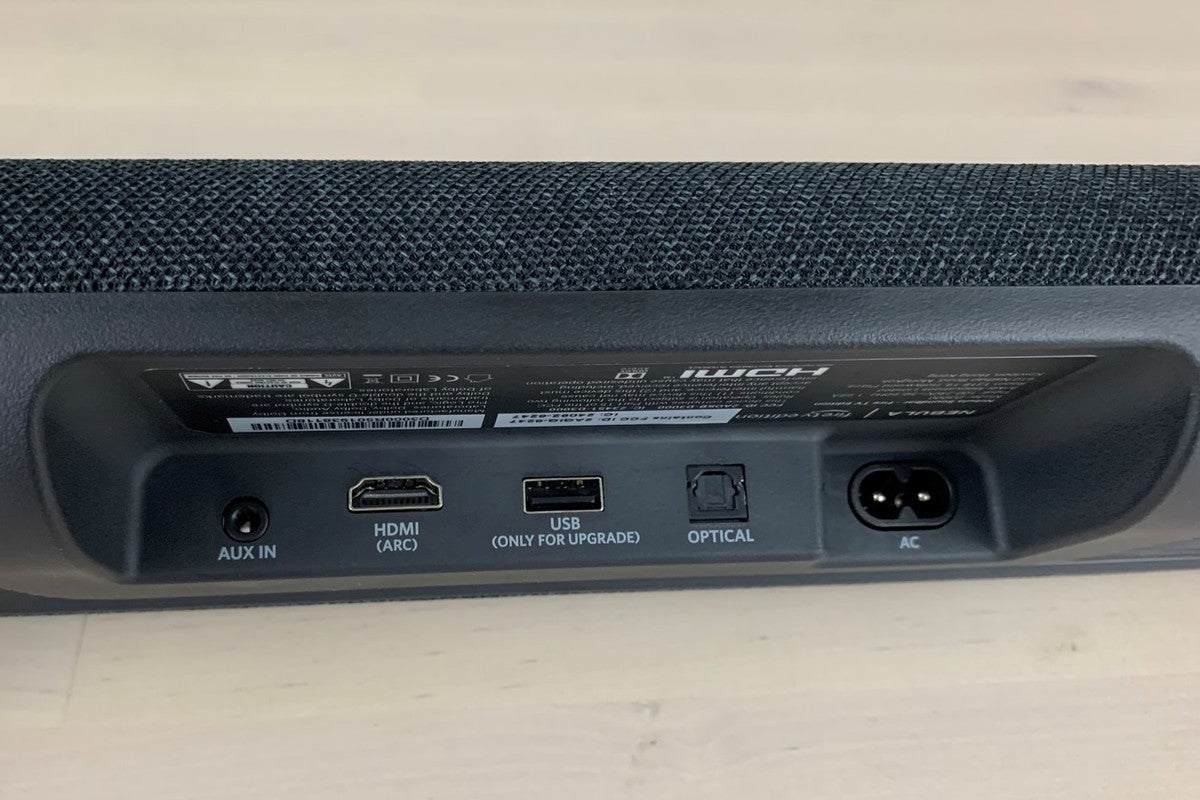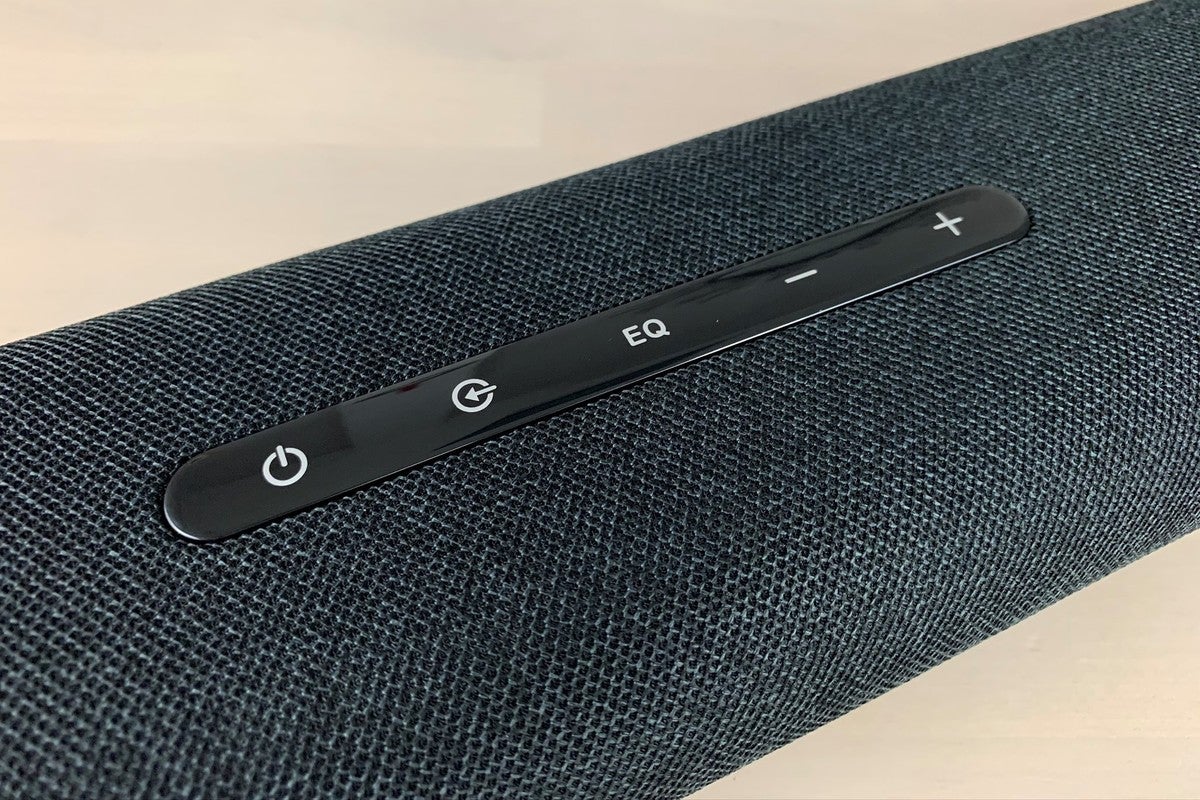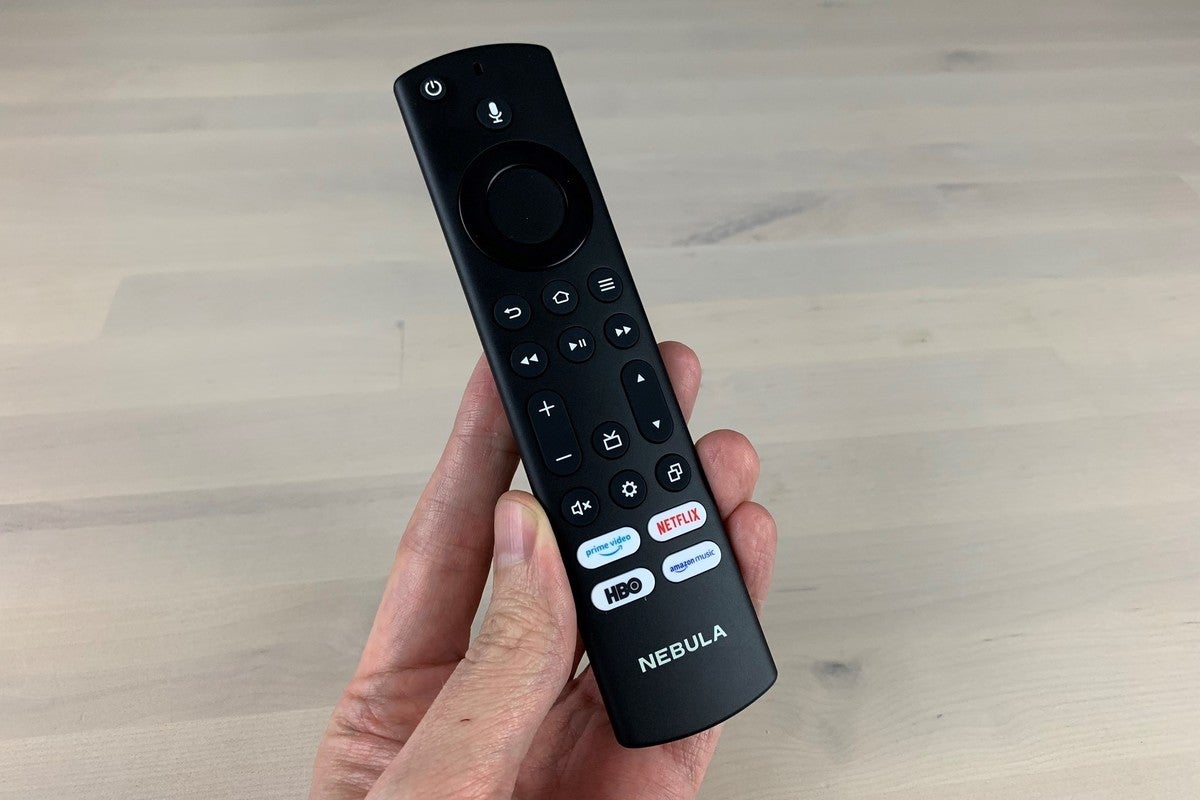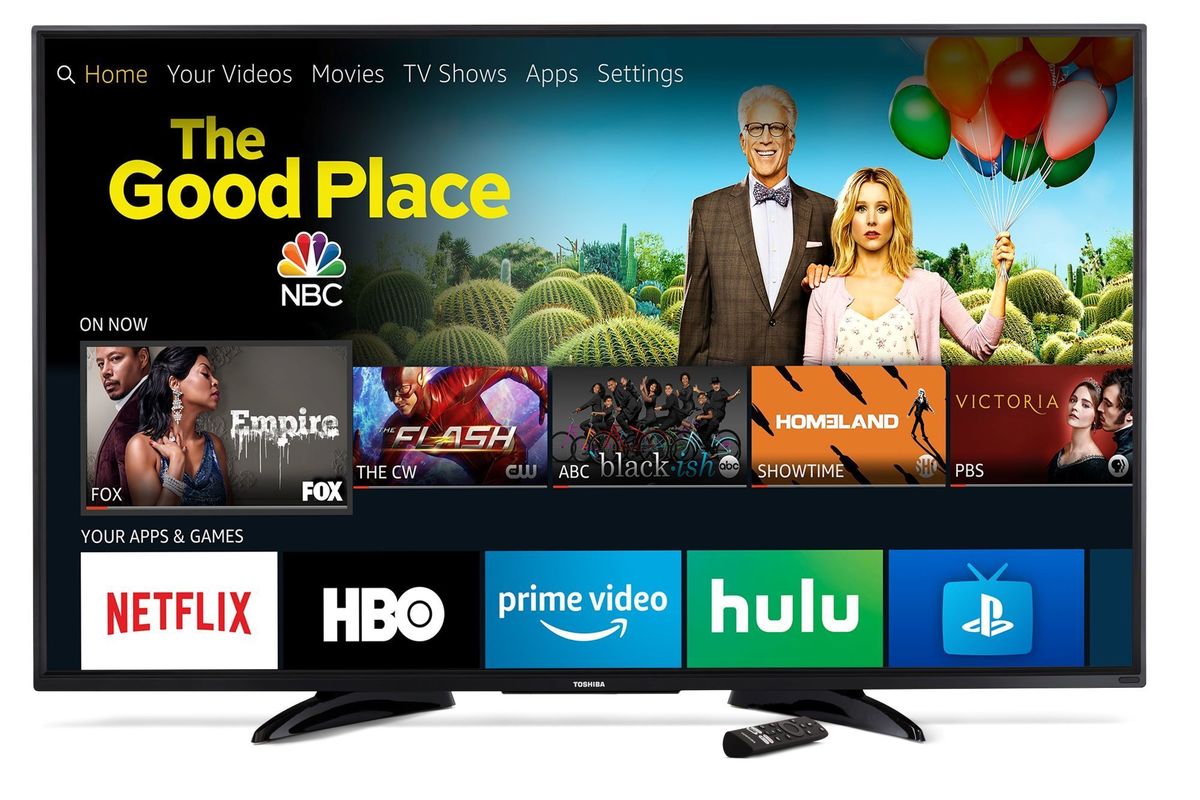For those looking to upgrade their TV’s audio and media-streaming capabilities without dealing with a nest of cables and dongles, an all-in-one soundbar like Anker’s Nebula Soundbar—Fire TV Edition is certainly appealing. This 2.1-channel soundbar boasts a built-in subwoofer, baked-in Fire TV interface, and Alexa voice control. You can boost your TV’s audio and stream video over the top by connecting just one component to your TV using a single cable.
The Nebula is similar to the $180 Roku Smart Soundbar in that respect, but while we love the convenience of the its video streaming and Alexa capabilities, its iffy audio performance—while certainly superior to that of most integrated TV speakers—leaves something to be desired.
This review is part of TechHive’s coverage of the best soundbars, where you’ll find reviews of competing products, plus a buyer’s guide to the features you should consider when shopping.
Configuration
While it lacks a discrete subwoofer, the Nebula Soundbar—Fire TV Edition Anker still bills this soundbar as a 2.1-channel system by virtue of its two built-in 3-inch woofers and bass ports on each side, while two 1.5-inch full-range drivers supply the left and right channels. There are no up-firing drivers, which means no Dolby Atmos or DTS:X support, although (as we’ll cover in a bit), the Nebula does have a (decent) virtual surround mode.
It’s also worth noting that for now, you can’t upgrade the Nebula to a 5.1-channel system by adding surround speakers, although an Anker rep didn’t rule out the possibility of a wireless surround kit in the future. Roku offers an optional wireless subwoofer for its system, and you can use Roku’s Wireless TV Speakers as surround channels.
Measuring 36.2 x 4.5 x 2.4 inches and weighing in at a little more than seven pounds, the fabric-covered Nebula has a rounded design and it’s fairly easy to carry, despite its bulk. The soundbar is short enough that you can plunk it down in front of most TVs without blocking the bottom of the screen, even in the case of my 55-inch LG C9 OLED TV (which has an unusually low-slung display stand). You could also mount the soundbar on a wall using the four mounting holes in the bottom of the unit; a bracket, screws, and a mounting guide are included.
Inputs and outputs
A middle cavity in the back of the Nebula offers just a trio of inputs: a 3.5mm analog audio input, an HDMI port with ARC (audio return channel) support, and an optical (Toslink) digital audio input. There’s also a USB Type-A port here, but it’s only for installing firmware updates, not for playing music files stored on a thumb drive.
 Ben Patterson/IDG
Ben Patterson/IDG
The Nebula soundbar features inputs for HDMI (ARC), optical, and analog cables, while the USB port is only for servicing the soundbar.
That single HDMI port is a tad stingy. Better soundbars come with at least a couple of them, so you don’t need to rely on your TV having several and supporting ARC in order to connect more than one source (e.g., a gaming console in addition to a cable or satellite TV set-top box and perhaps a Blu-ray player, for instance). And since the Nebula doesn’t support the higher-bandwidth eARC (an admittedly uncommon feature on soundbars), the Nebula can’t play back lossless audio formats such as Dolby True-HD or DTS-HD Master Audio soundtracks.
While the lack of eARC support limits your audio options, the soundbar does support 4K/HDR passthrough, including Dolby Vision, which means you’ll be able to watch streaming 4K HDR movies and shows from the likes of Amazon Prime Video, Disney+, and Netflix.
Setup
While the physical setup of the Nebula Soundbar—Fire TV edition is pretty straightforward, getting Fire TV up and running is a bit more tedious.
As far as the physical setup goes, there really isn’t much to it. Once you place the Nebula in front of your TV (or mount it on the wall beneath your TV), you connect it to your set via the HDMI, optical, or analog RCA jacks. Thankfully, Anker supplies all three of these cables in the box. Next, you connect the AC cord, which (I’m happy to report) doesn’t come encumbered with a power brick or wall wart, perfect for fitting the plug into a crowded power strip.
Once the Nebula is plugged in and connected to your TV, it’s time to start setting up Fire TV itself. First, you’ll need to select your Wi-Fi network and key in the password using the included remote and on-screen interface (assuming you’ve switched your TV to the correct input). The Nebula connected to my network on the first try, but using the remote’s navigation pad to punch in my wireless password was a bit of a drag.
After the Nebula has downloaded and installed any available updates (the process took about five minutes for me), it will prompt you to log into your Amazon account. If you don’t already have an Amazon account, you’ll need to create one before proceeding.
The Nebula doesn’t offer any shortcuts for verifying your account credentials, such as opening an app on your phone or entering a code from a desktop web browser; instead, you’ll have to (again) use the remote’s four-way navigation pad and the Nebula’s on-screen keyboard to punch in each character of your email address and password—and yes, that’s just as tedious as it sounds. If you’re lucky (I wasn’t), you’ll type in your entire email and password correctly on the first try.
Once that’s done, the Nebula will ask if you want to enable parental controls or start logging into streaming video or music services such as Hulu, Netflix, and Spotify—and yes, if you want to sign into most of those services, you’ll need to laboriously enter your account credentials using the remote. (A welcome exception was Disney+, which let me log in by simply launching the Disney+ app on my phone.) After that, you’re ready to dive into the Fire TV interface (which I’ll describe in a moment).
Controls, remote, indicators, and Bluetooth
A glossy plastic strip along the top of the soundbar cabinet features capacitive touch controls for power, input source, equalizer controls, and volume. A six-digit display that peeks out from behind the soundbar’s fabric covering tells you which input is selected, shows you the volume level, and guides you through the soundbar’s various settings.
 Ben Patterson/IDG
Ben Patterson/IDG
A glossy strip on top of the soundbar cabinet features buttons for power, input selection, equalizer settings, and volume up/down.
The Nebula’s remote has a somewhat cluttered collection of buttons, including a Home button that sits beneath a four-way navigation pad, an options button to the right of the Home button, a channel guide button (if you happen to subscribe to a live streaming TV service), and a recents button (which displays the recent shows, movies, and apps that you’ve accessed). Those are in addition to the standard play/pause, forward/reverse, volume and mute buttons, of course, not to mention the four labeled shortcut buttons near the bottom of the remote for Netflix, Amazon Prime Video, Amazon Music, and HBO.
That’s a lot of buttons to keep track of in the dark, yet some obvious ones—namely input, sound mode and Bluetooth—are missing. You can change input sources and sound modes using the remote by pressing Settings and digging into the menu, or you can enter Bluetooth pairing mode by pressing and holding the play/pause button, but I would have prefered dedicated buttons for those functions. Luckily, you can also control all the Nebula’s functions and settings using the Nebula mobile app.
 Ben Patterson/IDG
Ben Patterson/IDG
The Nebula’s remote is a bit cluttered for our taste, but pressing the Alexa button at the top lets you control the soundbar with voice commands.
Of course, there’s one button near the top of the remote that makes controlling the Nebula much easier: the Alexa button. Pressing and holding the button wakes Alexa, allowing you to say things like “Turn down the volume,” “Pause the movie,” “Change the input source to Bluetooth,” “Show me movies with Clint Eastwood,” and more. We’ll discuss how Alexa works with the Nebula’s Fire TV features in a bit.
Streaming tunes to from your iOS or Android device to the Nebula soundbar is easy, but as I just mentioned, you need to know the trick to entering Bluetooth pairing mode by pressing and holding the play/pause button; the soundbar should then appear in the list of available Bluetooth devices on your phone. Once I had the Nebula paired to my phone, I was able to stream music without any issues.
Unfortunately, the Nebula doesn’t support Apple AirPlay 2 or Chromecast, nor does it work as a Spotify Connect device unless you have the Spotify app for Fire TV running on the soundbar.
Fire TV and Alexa
After having spent a fair amount of time criticizing the Nebula’s cluttered remote, I’ll now heap some praise on the soundbar’s Fire TV and Alexa features, because they’re pretty great.
We’ve previously given Amazon’s Fire TV interface high marks in our reviews of other Fire TV products, including the Fire TV Stick 4K, and most of those accolades apply here, too. The Fire TV interface itself looks pretty typical, with a tabbed menu that includes live TV, your video library, movies, TV shows, apps, and soundbar settings. Of course, Amazon’s own offerings tend to be favored when it comes to browsing movies and shows, but if you’ve installed (for example) the Disney+ and Netflix apps, you’ll see plenty of offerings from those services as well.
 Vizio
Vizio
We’re fans of Amazon’s Fire TV interface, seen here on a Toshiba Fire TV Edition set.
So far, so good, but the real power of Fire TV lies in Alexa. Indeed, the fun really begins once you start asking Alexa to open apps, search for movies, turn down the volume, or jump back to the home screen. If you’re watching a movie on Amazon Prime Video and you want to jump to a selection of Star Wars films on Disney+, just press and hold the Alexa button and say, “Show me some Star Wars movies.”
You can also ask Alexa to show you the news, visit the soundbar’s settings menu, or open an app. And don’t forget that Alexa on the Nebula can do pretty much anything that she can do on an Echo-compatible smart speaker, meaning she can tell you the weather, play music, or turn off your smart lights. Indeed, the only thing she can’t do is wake up when you say “Alexa;” instead, you must press the Alexa button on the remote before speaking into the remote’s mic.
Performance
While the Nebula’s built-in Fire TV and Alexa capabilities will make it an enticing choice for those who want an easy way to jumpstart their home theater, the soundbar’s muddy audio won’t please audiophiles. Yes, the soundbar can get pretty loud, and its built-in woofers certainly deliver more bass than a TV’s speakers ever could, but the overall audio lacks the richness, depth, and detail that I’ve heard from competing soundbars, including some that cost half as much.
The soundbar features Movie, Music, and dialog-enhancing Voice modes, as well as a Surround mode that’s designed to widen the soundstate and enhance surround effects. After fiddling with the treble and bass settings a bit (those are the only other audio-related settings, by the way), I elected to leave them at their default settings. It’s worth noting that the Nebula lacks a night mode for normalizing the volume during late-night viewing.
I started my sound testing with the opening credits from 1978’s Superman, which features a remastered Dolby Atmos soundtrack that’s downmixed for the 2.1-channel Nebula soundbar. The whooshing credits and John Williams’ stirring score almost always manages to quicken my pulse, but the Nebula’s mediocre, somewhat muffled audio robbed the famous sequence of much of its excitement. And while I wasn’t expecting the thunderous bass of a separate subwoofer from the all-in-one Nebula, I was expecting more from the “thump” that usually accompanies Richard Donner’s “directed by” credit. At least the Nebula delivered some decent low-frequency rumbles during the opening of the giant dome on Krypton after the trial of General Zod.
Back on the plus side, the Nebula’s simulated surround mode exceeded my modest expectations during the scene when Zod and his lieutenants, Ursa and Non, are imprisoned by the Phantom Zone, which whooshes into the frame, scoops up the villains and then flies away and behind us. While the 2.1-channel Nebula can’t come close to the precision a 5.1 setup can deliver, its surround mode still managed to convincingly boost the soundstage and even add some ambient flavor in the rear.
Next up is one of my favorite audio tests: the launch sequence from Apollo 13. I’ll start with what I liked, beginning with the (again) solid virtual surround effects, particularly as the Saturn V’s fuel pumps gurgled prior to ignition, and again as the exhaust flames from the rocket engulfed the screen. I also appreciated the low-frequency rumbles from the built-in subwoofers, although I’ve heard better from other single-unit 2.1 soundbars. Then there’s the bad: muffled, dull audio that made it feel like I was wearing earmuffs.
"TV" - Google News
February 18, 2020 at 06:00PM
https://ift.tt/2Hyex27
Anker Nebula Soundbar—Fire TV Edition review: Great Fire TV and Alexa functionality, but so-so sound - TechHive
"TV" - Google News
https://ift.tt/2T73uUP
Shoes Man Tutorial
Pos News Update
Meme Update
Korean Entertainment News
Japan News Update
Bagikan Berita Ini















0 Response to "Anker Nebula Soundbar—Fire TV Edition review: Great Fire TV and Alexa functionality, but so-so sound - TechHive"
Post a Comment